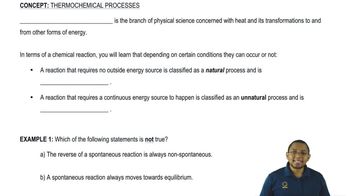Here are the essential concepts you must grasp in order to answer the question correctly.
Gibbs Free Energy (∆G)
Gibbs Free Energy is a thermodynamic potential that helps predict the spontaneity of a reaction at constant temperature and pressure. A negative ∆G indicates that a reaction can occur spontaneously, while a positive ∆G suggests that the reaction is non-spontaneous. In this case, the given ∆G of +16.3 kcal/mol indicates that the reaction is not spontaneous at 25 °C.
Recommended video:
Gibbs Free Energy (Simplified) Concept 3
Spontaneity of Reactions
The spontaneity of a chemical reaction refers to whether it can occur without external intervention. It is determined by the change in Gibbs Free Energy (∆G). If ∆G is negative, the reaction is spontaneous; if positive, it is non-spontaneous. Understanding this concept is crucial for evaluating the feasibility of the given reaction.
Recommended video:
Spontaneous Reaction Concept 1
Temperature's Role in Reaction Spontaneity
Temperature can significantly influence the spontaneity of a reaction, as it affects the enthalpy and entropy changes associated with the reaction. The Gibbs Free Energy equation (∆G = ∆H - T∆S) shows that at higher temperatures, the entropy term (T∆S) can become more significant, potentially making a reaction spontaneous even if it is non-spontaneous at lower temperatures. However, in this case, the positive ∆G indicates non-spontaneity regardless of temperature.
Recommended video:
Spontaneous Reaction Concept 1
 Verified step by step guidance
Verified step by step guidance Verified Solution
Verified Solution



 0:46m
0:46m